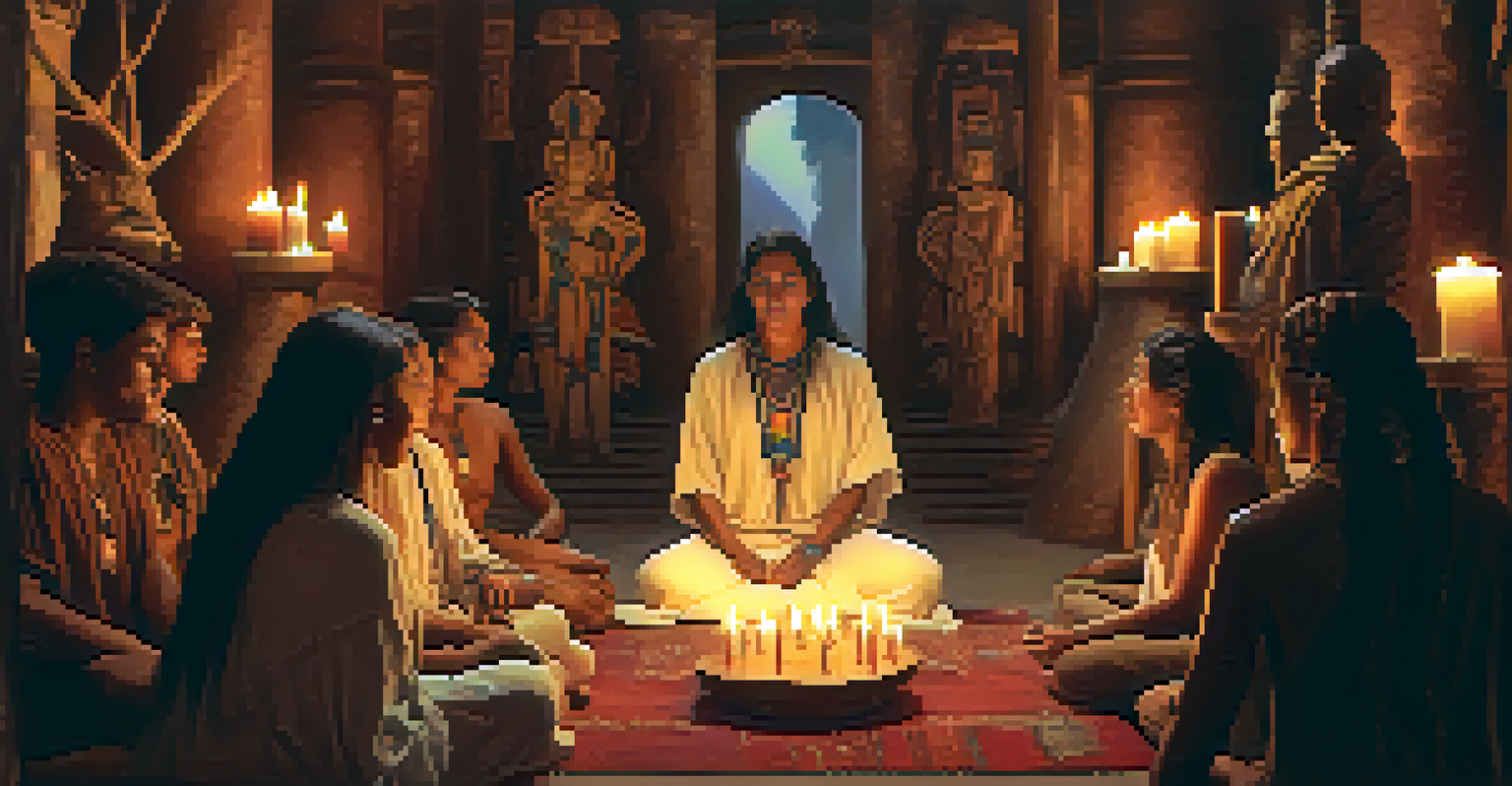Rituals and Hallucinogens: A Psychological Exploration

Understanding Rituals: More Than Just Traditions
Rituals are fascinating cultural practices that go beyond mere traditions; they serve as a framework for human behavior and community bonding. They can range from daily habits to elaborate ceremonies, often designed to instill a sense of belonging and purpose. For many, participating in rituals can evoke deep emotional responses, facilitating connection with others and oneself.
Rituals are the formula by which harmony is restored.
In psychological terms, rituals can act as coping mechanisms, providing structure in times of uncertainty. Think of how a morning coffee routine can ground you before a busy day. This grounding effect can be especially powerful when combined with hallucinogens, as both can alter perceptions and create profound experiences.
Ultimately, rituals encourage mindfulness and presence, making them an intriguing subject of study, especially when intertwined with the effects of altered states of consciousness. The exploration of this relationship opens doors to understanding how our behaviors shape and are shaped by our mental landscapes.
Hallucinogens: The Mind's Altered States
Hallucinogens are substances that significantly impact perception, mood, and cognitive processes. They can lead to experiences that feel profoundly spiritual or transformative, often described as 'ego dissolution' or a sense of oneness with the universe. These experiences can vary widely from person to person, which makes studying their psychological effects both intriguing and complex.

Common hallucinogens include substances like LSD, psilocybin mushrooms, and peyote. Each affects the brain differently, often enhancing sensory experiences and altering the perception of time and space. People frequently report heightened creativity or insight during these experiences, which ties back to the therapeutic potential of such substances when used in controlled settings.
Rituals Enhance Emotional Healing
Combining rituals with hallucinogens can create a supportive environment for deeper introspection and personal growth.
Research into hallucinogens is gaining momentum, particularly in their application for mental health treatment. Studies suggest that, when combined with supportive environments—like structured rituals—they may help alleviate conditions such as depression, PTSD, and anxiety, providing a new avenue for psychological healing.
The Psychological Benefits of Rituals with Hallucinogens
When rituals are paired with hallucinogenic experiences, they can enhance the psychological benefits of both practices. The structured environment of a ritual can provide a safe space for individuals to explore their subconscious during hallucinogenic experiences. This combination often leads to deeper introspection, promoting emotional healing and personal growth.
The mind is everything. What you think you become.
For instance, in some cultures, rituals involving hallucinogens are conducted with the guidance of a shaman or facilitator, creating a supportive framework for participants. This guidance helps individuals navigate their experiences and integrate insights gained during their journey, which can be pivotal for mental health recovery.
Moreover, the communal aspect of ritual can foster a sense of belonging and shared experience, which is crucial for emotional well-being. This collective engagement can amplify the positive effects of hallucinogens, making the process not just about individual transformation but also about strengthening community bonds.
Cultural Perspectives on Rituals and Hallucinogens
Different cultures have long recognized the power of combining rituals with hallucinogens as a means of spiritual connection and healing. Indigenous tribes in the Amazon, for example, use ayahuasca in ceremonial settings to promote psychological and spiritual well-being. These practices emphasize the importance of context, as the environment plays a crucial role in shaping the experience.
In many cultures, these rituals are not just about the substances themselves but also about the stories, songs, and traditions that accompany them. They create a rich tapestry of meaning that enhances the experience, allowing participants to tap into shared knowledge and history. This contextual understanding can significantly alter the psychological impact of hallucinogens.
Cultural Importance of Practices
Different cultures have long utilized rituals and hallucinogens together for spiritual connection and psychological well-being.
As we explore these cultural practices, it becomes clear that the integration of rituals and hallucinogens serves not only personal healing but also community cohesion. The shared experience fosters connection, understanding, and collective healing, highlighting the importance of cultural context in psychological exploration.
The Science Behind Rituals and Hallucinogens
Research into the psychological effects of rituals and hallucinogens is still evolving, but initial findings are promising. Studies indicate that hallucinogens can trigger neuroplasticity, allowing the brain to form new connections and pathways, which is essential for healing. When combined with rituals, these effects may be amplified, fostering deeper emotional processing and integration.
Additionally, the act of engaging in rituals can activate specific brain regions associated with meaning-making and emotional regulation. This activation can create a fertile ground for the insights gained during a hallucinogenic experience to take root and flourish, leading to lasting change in perspective and emotional health.
By understanding the neuroscience behind these practices, we can begin to appreciate why they are so impactful. This scientific approach not only validates traditional practices but also opens up avenues for therapeutic applications in modern psychology.
Potential Risks and Considerations
While the combination of rituals and hallucinogens can offer significant psychological benefits, it is essential to acknowledge potential risks. Not everyone may respond positively to hallucinogens, and some may experience anxiety or discomfort during their journeys. Therefore, ensuring a safe and supportive environment is key to mitigating these risks.
Furthermore, the legality and accessibility of hallucinogens vary widely around the world, which can complicate their use in therapeutic settings. It’s vital for individuals to be aware of local laws and to seek guidance from qualified professionals when considering such experiences.
Research Validates Healing Potential
Studies suggest that the combination of rituals and hallucinogens may amplify therapeutic effects, promoting neuroplasticity and emotional regulation.
Lastly, understanding one’s mental health history is crucial before engaging in hallucinogenic practices. Individuals with a history of certain mental health conditions may be more susceptible to negative experiences, underscoring the importance of informed decision-making in this complex and nuanced field.
Future Directions: Research and Practice
As interest in the psychological effects of rituals and hallucinogens grows, future research will likely focus on their therapeutic potential. Clinical trials are being conducted to explore how these practices can be integrated into conventional mental health treatments, paving the way for more holistic approaches to healing. This could revolutionize how we understand and treat various psychological conditions.
Moreover, as we continue to learn about the interplay between rituals and hallucinogens, there may be opportunities to develop new therapeutic modalities that incorporate these elements. Mental health professionals may find innovative ways to create structured environments that enhance the positive effects of hallucinogens while ensuring participant safety.

The future of this field looks promising, with the potential for new insights into human consciousness, community, and healing. By embracing both scientific research and cultural wisdom, we can forge a path toward more effective and compassionate mental health care.